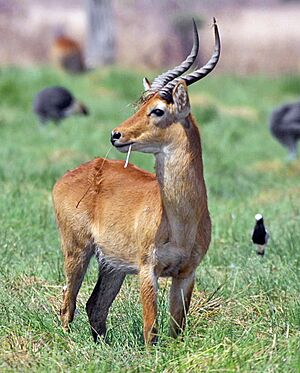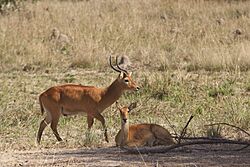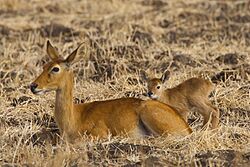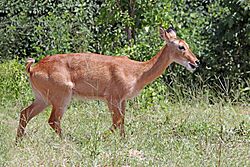Puku facts for kids
Quick facts for kids Puku |
|
|---|---|
 |
|
| Male (Zambia) | |
| Conservation status | |
| Scientific classification | |
 |
The puku (scientific name: Kobus vardonii) is a type of antelope. It's a medium-sized animal that lives in wet grasslands. You can find puku in parts of southern Democratic Republic of Congo, Namibia, Tanzania, and Zambia. They are especially common in the Okavango Delta in Botswana.
Sadly, the places where puku live are shrinking. Because of this, almost one-third of all puku now live in protected areas, zoos, and national parks. This helps keep them safe.
What Puku Look Like
Puku are about 80 cm (31 in) tall at their shoulder. They usually weigh between 70 to 80 kg (150 to 180 lb). Their fur is a sandy brown color. The fur on their belly is a bit lighter.
Their coat feels rougher than other similar-sized antelopes. These include the southern reedbuck, lechwe, or impala. It's also rougher than the smaller oribi. Only male puku have horns. These horns are ridged and shaped like a lyre, which is a type of harp. They can grow up to 50 cm (20 in) long.
Types of Puku
There are two main types, or subspecies, of puku. They are slightly different depending on where they live.
- The Senga Puku (Kobus vardonii senganus)
- The Southern Puku (Kobus vardonii vardonii)
Puku Habitat and Behavior
Puku mostly live in marshy grasslands and areas called dambos. These are wet, grassy plains. Puku love to eat different kinds of grass. They don't usually compete with other grazing animals for food.
Puku are most active during the early morning and late afternoon. This means they are crepuscular animals. If a puku gets scared, it will make a loud, shrill whistle sound.
Female puku live together in herds. These herds can have up to 20 females. During the rainy season, many herds might join together. This gives them extra safety, and these larger groups can have around 50 females. Male puku claim their own areas, called territories. They try to get female herds to stay in their territory for as long as possible.
When their habitat floods during the wet season, puku move to higher ground. In the dry season, they stay close to water sources.
Gallery








